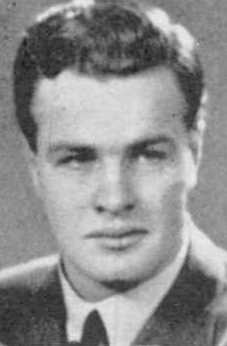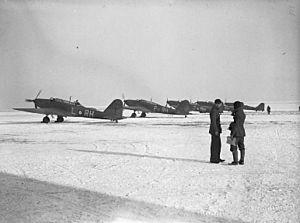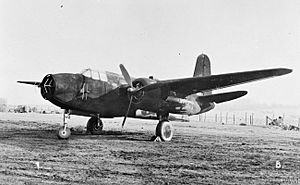Paul Rabone facts for kids
Quick facts for kids
Paul Wattling Rabone
|
|
|---|---|
 |
|
| Born | 2 March 1918 Salisbury, England |
| Died | 24 July 1944 (aged 26) North Sea |
| Allegiance | United Kingdom |
| Service/ |
Royal Air Force |
| Years of service | 1938–1944 |
| Rank | Squadron Leader |
| Unit | No. 515 Squadron No. 23 Squadron No. 488 Squadron No. 422 Flight No. 145 Squadron No. 88 Squadron |
| Commands held | No. 1528 Beam Approach Training Flight No. 1451 Flight |
| Battles/wars | Second World War
|
| Awards | Distinguished Flying Cross |
Paul Wattling Rabone DFC (born March 2, 1918 – died July 24, 1944) was a brave New Zealand fighter pilot. He was known as a flying ace because he shot down many enemy planes. Paul flew for the Royal Air Force (RAF) during the Second World War.
He was born in Salisbury, England, but grew up and went to school in New Zealand. In 1938, he joined the RAF. His first unit, No. 88 Squadron, went to France when the war started in September 1939. Paul flew a Fairey Battle bomber during the Battle of France and was shot down twice.
After fighting in France, he returned to England. He then joined Fighter Command and flew in the famous Battle of Britain. Later, he started flying at night, stopping enemy bombers during the Blitz. He also flew special missions into France. Paul also spent time teaching other pilots.
In 1942, he became a flight commander for No. 488 (NZ) Squadron. This squadron trained for a long time before starting night missions over France. From June to December 1943, he flew with No. 23 Squadron, helping with battles in Italy. Paul Rabone was killed during a mission over Germany. By the time he died, he was credited with shooting down nine enemy aircraft.
Contents
Paul's Early Life
Paul Wattling Rabone was born in Salisbury, England, on March 2, 1918. He was the oldest son of Clarence Rabone and his wife. His father was from Christchurch, New Zealand. Paul went to school in Palmerston North and New Plymouth.
After school, he worked on a farm. He also joined the Territorial Force, which was a part-time army unit, where he served in an artillery group.
Becoming a Pilot
In early 1938, Paul applied to become a pilot in the Royal New Zealand Air Force (RNZAF). He learned to fly at civilian clubs, like the Auckland Aero Club. After getting his pilot's license in April, he was accepted into the RNZAF.
Two months later, he went to the RNZAF's flight training school. He earned his pilot's wings in October. In February 1939, he was sent to England to join the Royal Air Force (RAF). There, he officially became an RAF pilot officer on March 15, 1939. He was then sent to No. 88 Squadron, which flew Fairey Battles. These were monoplane light bomber aircraft based at Boscombe Down.
Paul's Service in World War II
Just before the Second World War began, No. 88 Squadron moved to France. It was part of the Advanced Air Striking Force. During a quiet period called the Phoney War, the squadron flew missions to gather information.
Fighting in France
When the Battle of France started in May 1940, Paul's squadron began attacking enemy targets. On May 10, they attacked a bridge in Maastricht. During this mission, Paul's plane was hit by anti-aircraft fire. He and his crew had to parachute out. They landed behind enemy lines but managed to get civilian clothes. After walking for five days, they reached Dieppe. There, they found three damaged Hawker Hurricane planes. Paul used parts from two planes to fix one. He then flew it back to England.
Paul rejoined his squadron, which was still in France. On June 12, he was shot down again by a Messerschmitt Bf 109 fighter. This happened during another bombing mission, this time targeting a bridge over the Seine river. He and his crew parachuted out and landed safely behind British lines. A few days later, they returned to No. 88 Squadron. Soon after, the squadron moved back to England. While in France, Paul had flown 16 missions.
The Battle of Britain
Paul volunteered to join Fighter Command. In August, he was sent to No. 145 Squadron, which flew Hurricane planes. This squadron was resting at Drem after fighting in the Battle of Britain. Two months later, the squadron moved to Tangmere. By this time, Paul had been promoted to flying officer.
On October 12, he met two Bf 109 fighters near Dungeness. They attacked him from out of the sun. All three planes flew in a tight circle. When one of the Bf 109s broke away, Paul shot it down. He managed to escape the other enemy plane. He landed back at Tangmere, and his plane had over 30 bullet holes!
Night Missions
Later in October, Paul moved to No. 422 Flight. This unit flew Hurricanes from Shoreham. They flew patrols during the day and tried to stop enemy planes at night. On November 6, he shot down another Bf 109. Later that month, he had to make two emergency landings.
In December, his unit became a night-fighting squadron, called No. 96 Squadron. Their job was to defend the Midlands area of England. On the night of December 22, about 300 enemy bombers attacked Manchester and the Midlands. Paul saw the glow from an enemy bomber's exhaust and shot it down. It was one of only three enemy planes destroyed that night. On another patrol, his engine failed, and he had to parachute out. He landed safely in a park in London.
Soon after, he was promoted to flight lieutenant and became a flight commander. By April 1941, the squadron was flying Boulton Paul Defiant planes. On April 5, 1941, Paul was flying a Defiant on a night patrol when his engine failed again. He and his gunner parachuted out over Derbyshire.
The next month, he moved to No. 85 Squadron, which flew Douglas A-20 Havoc planes. After two months of night missions, he was made commander of No. 1451 Flight. He was given the temporary rank of squadron leader. His unit flew special Havoc planes called Turbinlites. These planes had a powerful searchlight in their nose. They used radar to find enemy planes at night. Once found, the searchlight would light up the enemy plane so an accompanying Hurricane from No. 3 Squadron could shoot it down. Paul led this flight until October.
Paul then went to Kenley to learn about controlling fighter planes. He was later put in charge of a new unit, No. 1528 Beam Approach Training Flight. This unit helped pilots learn how to land planes using special radio signals.
In June 1942, No. 488 (NZ) Squadron, a New Zealand unit, was formed. It was a night fighter unit flying Bristol Beaufighters. Paul became one of its flight commanders. After training, the squadron moved to Scotland. Paul's flight was sent to Drem to target German spy planes flying over the North Sea.
From early 1943, the squadron began attacking enemy targets, called 'Ranger' patrols, during moonlight nights. On February 16, Paul flew with his commander and another pilot on the first of these missions to France. Paul had to turn back because of bad weather. These missions continued for months, usually targeting trains and railway lines.
Missions in Italy
At the end of April, Paul stopped flying active missions for a while. He returned to his regular rank of flight lieutenant and taught at training units. In mid-June, he was sent to No. 23 Squadron, which was based in Malta. This squadron flew de Havilland Mosquito planes on intruder missions into Italy. Soon after he arrived, he became a flight commander again and got his temporary rank of squadron leader back.
He regularly flew missions attacking enemy transport vehicles and airfields. One time, he attacked three CANT Z.506 Airone floatplanes (planes that land on water) at Lake Bracciano. He also shot down a Junkers Ju 88 medium bomber into the sea. At that time, he was flying a Supermarine Spitfire and delivering spare parts to a part of his squadron in Palermo. On September 8, his squadron was in Sicily. Paul shot down another Ju 88 and a Heinkel He 111 medium bomber during an attack on an airfield at Grosseto. He also damaged a second He 111 during that raid.
Later Missions and Final Flight
Paul returned to the United Kingdom in November and went back to teaching. In early 1944, he was given the Distinguished Flying Cross for his bravery. This award was announced on January 25, 1944.
He returned to flying missions in March 1944 with No. 515 Squadron. By this time, his time with the RAF had ended, and he transferred back to the RNZAF. With No. 515 Squadron, he flew Mosquito planes on intruder missions from Little Snoring to enemy airfields in France. He also protected planes that were laying mines. In June, the squadron started daytime missions, called 'Rangers', to support the Allied invasion of France. The goal was to make the enemy fighters come out and fight. On June 21, Paul shot down a Messerschmitt Bf 110, which was the squadron's first daytime victory. At the end of the month, he destroyed a He 111 as it landed and then shot down a Junkers W 34.
In July, Paul was sent back to No. 23 Squadron, which had also returned to England. His last mission was on July 24, when he flew to Germany to attack a target. He did not return from this mission. His body was found a few months later at Heligoland and was buried there. After the war, his remains were moved and re-buried in Belgium, at Hotton War Cemetery.
Paul was married to Pamela née Buchanan on September 12, 1941. He was a true flying ace, officially credited with destroying nine enemy aircraft. He also damaged one, and damaged three more while they were on the water.



